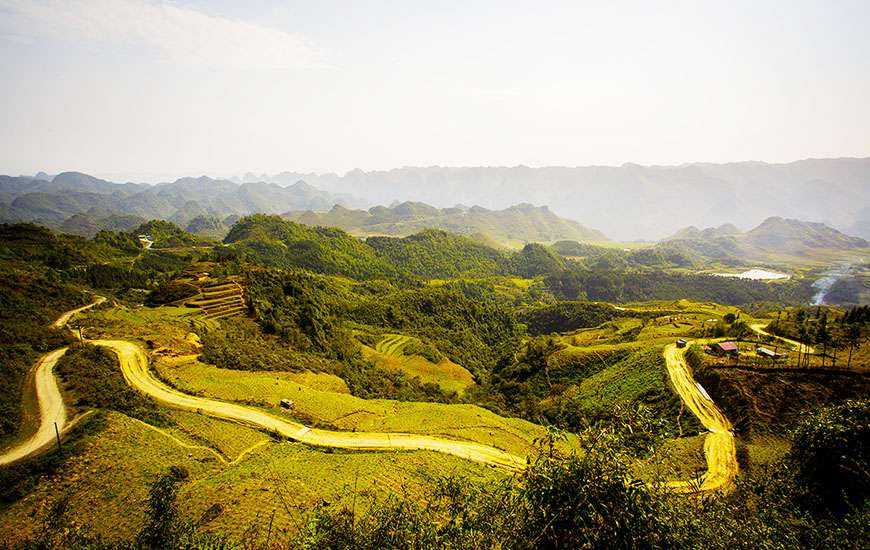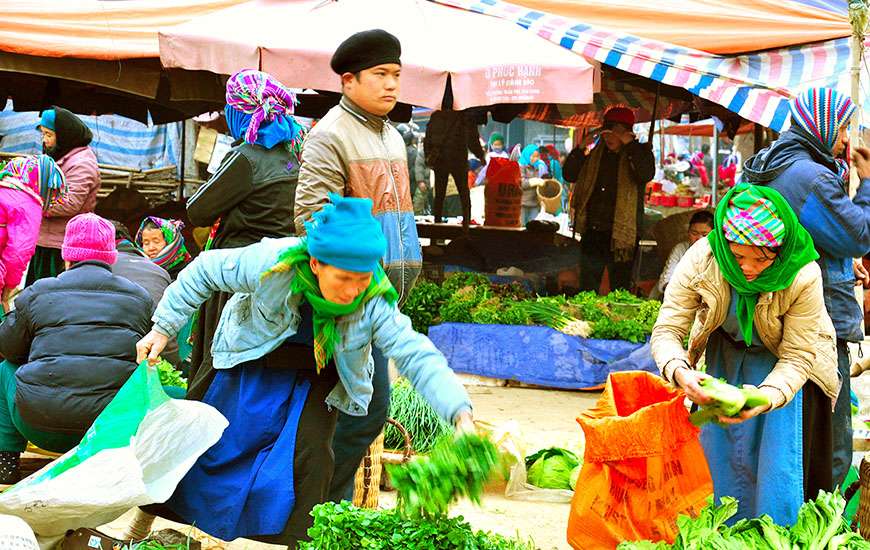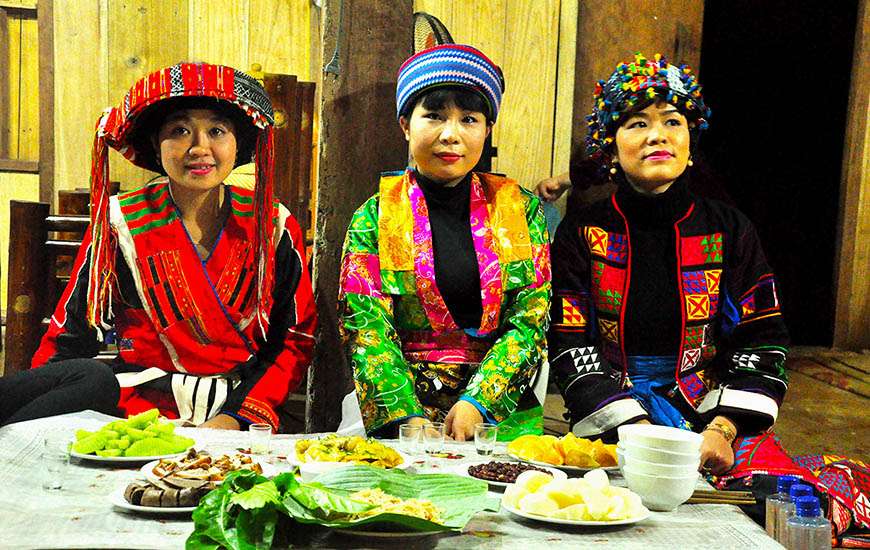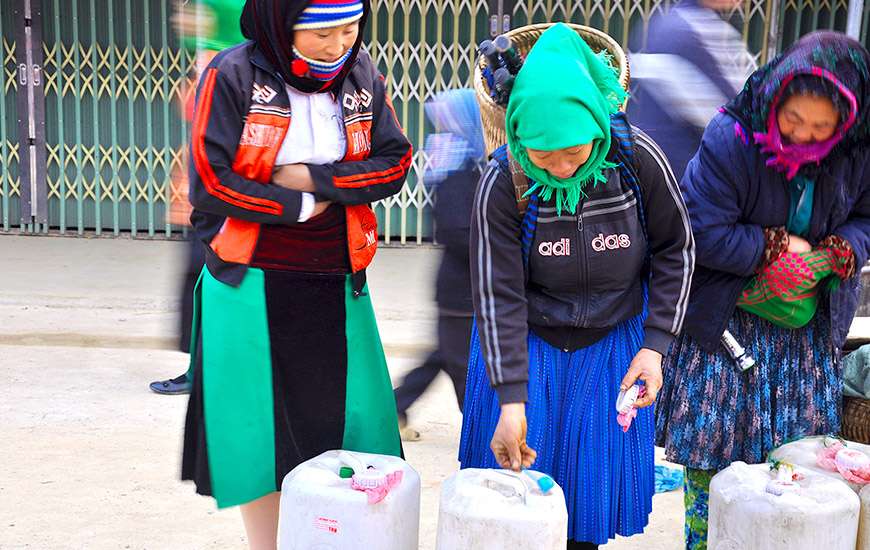Updated November 2023
Ha Giang at a glimpse
Located in the northernmost region of Vietnam, Ha Giang Province is famous for its stunning natural beauty, which includes towering limestone cliffs, deep valleys, and traditional villages. Several ethnic minority groups live in the region, each with their own culture and traditions.
Where is Ha Giang:
Ha Giang is located in Vietnam's Ha Giang region, approximately 310 kilometers north of Hanoi.
Going to Ha Giang from Hanoi
The best way to get to Ha Giang from Hanoi is to take a minibus, which takes around 6.5 hours and costs approximately 420,000 VND ($17)
The best time to visit Ha Giang
The best time to visit Ha Giang is from September to November when the weather is mild and dry.
What to see & do
Paradise for nature lovers and adventure seekers, Ha Giang is well-know for :
The Ha Giang Loop : A 350-kilometer round-trip journey through majestic landscapes of pinnacle limestone cliffs, deep valleys, and traditional villages..
- The Dong Van Karst Plateau Geopark: A UNESCO-designated geopark that is home to ethereal 400 million years old karst formations.
- The Quan Ba Heaven Gate: A beautiful mountain pass with stunning views of the surrounding landscape..
- The Lung Cu Flag Tower: The northernmost point of Vietnam, with a tower that provides panoramic views of the surrounding countryside.
Where to stay
Ha Giang offers a range of accommodation options, including hotels, hostels, and homestays. Choose between Ha Giang Backpacker Hostel, Pao's Sapa Leisure Hotel or a Homestay, which offers a unique opportunity to experience the local culture and traditions by staying with a local family
What to taste
- Ha Giang is known for its rustic but delicious local cuisine, which includes:
- Thang Co, the traditional stew made with horse meat, organs, and bones.
- Au Tau Porridge, made with glutinous rice, ginger, and peanuts.
- Banh Cuon, a kind of steamed rice roll filled with minced pork and mushrooms.
Ha Giang overview
Ha Giang is on Vietnam’s most northerly regions with a unique geographical makeup and diverse range of cultures. The mountainous area with towering limestone peaks, share a 270 km border with neighbouring China and plays host to the border crossing at Thanh Thuy. This remote and stunningly beautiful area is one of the last areas of Vietnam that requires tourists to obtain a visa in order to visit, but not to worry it is relatively cheap and easy to purchase one. Although gaining popularity with tourists, this remarkable area is still off the beaten track and goes unnoticed by many. Those that do make it to what is known as the “
Final Frontier of Vietnam” are rewarded by sweeping views of karst mountains, carpets of flowers, colourful markets and rich, diverse ethnic minority communities.
Like much of Vietnam, Ha Giang has had a turbulent past with invasions from both neighbouring China and the French colonials but today the magnificent mountain region sits quietly in peace. Now it is home to
ethnic minority communities such the Tay, H’mong, Nung, Giay, Lo Lo and Pu Peo who all have their own unique and fascinating cultures. The interaction of environment and people is evident in the scenery with the iconic terraces of rice fields spilling down the edges of the vast mountains.
Ha Giang is the perfect place to explore on bike or by foot, climbing the dizzying passing that clings to the sides of the mountains to experience unrivalled views of the incredible border region.

The view from a viewpoint along the road between Ha Giang and Dong Van.
See and Do
The Ha Giang Museum is a good first stop on your discovery of this beautiful and diverse northern territory. It is in close proximity to the Ha Giang permit office and can give you some information about the area and the different ethnic minorities living there. It features many interesting pieces and showcases hand-made, traditional outfits ethnic minority communities. It also features ancient artefacts that have been uncovered in archaeological digs in the area. Let the museum spark your interest as you begin your exploration of this remote area of Vietnam.
The
Dong Van Karst Plateau Geopark is one of the main draws of this northerly region. Set over 2,346 km2 of rocky mountains and valleys, the incredible landscape is home to many ethnic minority communities. It also offers a great insight into the history of the area with fossils from 500-600 million years ago. The stone forests merge into real forests as the slopes of the mountains strike out into the sky. The mountains behind the long, flat plateau are jagged and dramatic but appear softened by the clouds that gather at the peaks. Spring is the best time to visit when the vivid yellow cai (kale) flowers and subtle pink peach flowers bloom en mass, their sweet hues contrasting with the rich, green forest and cold grey stone.
The view from Quan Ba Twin Mountains, located behind Quan Ba Town.
Tucked away in the valley village of Sa Phin, guarded by rows of tall trees, and encased by a stone wall, sits the regal Vuong Palace. Built in 1914 for Vuong Chinh Duc, a Hmong king, this palace has survived both the French and American wars. The large structure features intricate carvings of poppies which represent the opium that was once traded here. You can get a feel for the life of a rich H’mong king as you wander through the ornately decorated rooms and imagine the hoards of precious goods that were stored in underground rooms.
One of the best ways to take in the stunning scenery of Ha Giang is with a road trip either by motorbike or 4x4 vehicle. The mountainous roads will show you the amazing, unspoilt, natural beauty of this border region. One of the most popular routes is from
Dong Van town to
Meo Vac along the astonishing
Mai Pi Leng Pass. This winding road appears to be perched precariously on the edge of the staggering mountains. The long thin road cuts through the cascading terraces of rice paddies. Driving along this stunning pass, among the towering mountains will make you feel incredibly small as if you are lost in the immensity of nature. From here you will have unrivalled views of the winding and glassy Nho Que river that snakes between the two sides of the mountain range.
Another stunning road trip runs along
Quan Ba Pass which overlooks a Red Dao village. The view from this great height spans the karst geopark with the patchwork of the plateau in the foreground and the mountains fading into the distance.
A view of Nho Que River and Ma Pi Leng Pass.
As you drive along these dizzying mountain roads, you are sure to be captivated by the incredible artistry of the rice paddies that are sculpted into the soaring mountains. The best place to see this is the are of
Hoang Sui Phi where the tiny scattered villages rely on rice agriculture to survive. The cascading paddies of this remote land are some of the most dramatic in the whole of Vietnam. Surrounded on either side by waterfalls of green that start high in the skies and tumble elegantly down the mountains, you can’t help but feel lost in the power of nature. This is the perfect example of how humans can interact with nature to create something beautiful and harmonious. This remote area, unknown to most tourists is also the perfect place to meet some of the local people living in the ethnic minority communities. The area is home to H’mong, Red Dao and Nung ethnic groups, who all have unique traditions and cultures. You can discover more about their heritages and uncover the secrets of rice farming as you travel through this remarkable area. You can even stay with one of the local families and discover their hospitality and kindness.
Another place with spectacular views of Ha Giang is the
Lung Cu Flag Tower. This octagonal tower sits proudly atop a green carpeted mountain, flying a giant Vietnamese flag. This symbol of national pride demarcates the northernmost point of Vietnam. You can climb the tower for an incredible panoramic view of Ha Giang’s beautifully preserved countryside.
Culture and Arts
One of the best places to immerse yourself in culture is at the Sunday markets. Here you can meet local people from the surrounding ethnic minority communities. You can peruse the melee of goods on offer and be part of the week’s biggest social event. One of the biggest and busiest is the Dong Van Market which is held every Sunday morning. From the early hours of the morning, when the sunshine is just breaking over the mountains, local people from the surrounding areas will be getting themselves and their goods ready for market. People dress in their finest attire, especially the young women who show their excitement for this social event through their dazzling dresses. As the girls arrive in their stunning outfits, the stalls are set up and ready for a busy day of trading and the men sit down to eat breakfast and share rice wine. The stalls are piled high with brightly coloured traditional outfits, handmade incense and mounds of fresh fruit and vegetables. As well as the people, there are also hoards of animals at this market. From the big, slow buffalo and scampering pigs to cages of chirping birds and broods of chickens.

Local women at Dong Van Market.
Another unique market is the
Meo Vac Cattle Market, also held on Sunday but at the other end of the stunning Mai Pi Leng Pass. This market gives you the chance to explore the H’mong culture and meet the local people. Here you can see their traditional outfits; the men dressed in their simple black attire, and the women dressed in their beautifully embroidered ensembles and colourful head scarfs. Many of the villagers bring their finest animals either to sell or simply to show off their hard work. The usual market rhythm of bartering and chit-chat is accompanied by an orchestra of animal noises and the sound of children playing.
►
Experience our Ha Giang Loop Trekking 4 days!
Local women with their pigs at the livestock market.
Festivals and Events
The first three months of the lunar calendar are crowded with different festivals all across Asia. This is the beginning of the new year and each year begins with the cultivation of a new crop rice and many ceremonies to give thanks to the gods. Each different ethnic minority community has their own take on the Spring Festival with unique, colourful ceremonies held across the region.
One the most unusual and unique festivals of Ha Giang is the annual Khau Vai Love Market which draws people from people all fo the different ethnic communities in the area. Unlike most markets, this is not a trading event, it is a bittersweet opportunity for ex-lovers to meet and reminisce of past romance without any judgement or ill feeling from spouses. For many people living in the ethnic minority communities of Ha Giang, marriage is not based solely on love but also on cultural and practical factors. This system results in many forbidden relationships and the love market is a way of expressing these prohibited partnerships. The festival itself is based on the romantic tragedy of a forbidden love between a girl and boy from different tribes. After much fighting between the tribes, the pair decided to end their affair and agreed to meet in secret once a year on the 26th day of the third lunar month. Here you can witness a sea of people all adorned in their finest outfits searching out their past lovers for a walk down memory lane. Even in the massive crowds of people, the atmosphere is intimate and touching. The younger generation also looks forward to this event as they prepare to meet a potential suitor, bringing the festival into the 21st century, using mobile phones to arrange dates.

Local girls in their amazing traditional outfits.
Another unique and exciting festival in Ha Giang is the annual Pa Then Fire Dance Festival. Held in Bac Quang in October and November of the lunar calender, this is the traditional festival of the Pa Then ethnic minority community. Ceremonies and rituals are held to pray to the fire god for luck, health and happiness. After, the men of the village show their bravery as they perform impressive leaping dances on flaming fires. Their absence of fear enhances the admiration as the rest of the villagers gather round, the women dressed in remarkable traditional outfits to cheer and applaud their courage.
Because of the agricultural lifestyle of many of the communities in Ha Giang, there are lots of festivals that pray for favourable crop growing conditions. The Lo Lo ethnic minority community holds a Rain Festival each year during the dry months of March. The festival features offerings to the mother and father of the universe to ask for good weather. All of the villagers come together in their traditional, colourful outfits and each household makes a contribution. People play the traditional instruments of bronze drums and two-stringed fiddles and the village mystic invites ancestral spirits to join the ceremony. After the ceremony, there is a lively celebration where people can share delicious local food and drink and people engage in folk dancing and traditional games.
Food and Drink
One of the most famous dishes from this mountainous region is Thang Co, a hot and aromatic soup served from market stalls to crowds of people perched on small benches. Made from horse, cow or buffalo this dish makes use of all of the edible parts of the animal. The fragrant steam that wafts up from the giant pans floats through the cold air and fills it with the scent of lemongrass and cardamom. This hot steaming soup is bound to fill you with warmth and comfort on a cold winter day.
Another comfort food to ward off the cold is Au Tau, a Ha Giang version of the classic rice gruel dish which is slightly bitter in taste. Glutinous rice is combined with au tau, pig’s trotters and a special mix of spices to create a unique and warming dish characteristic of the region. People nourish themselves in the evening with this glutinous and flavoursome dish that is thought to ward off the health problems inflicted by the cooler climates.
Five colour sticky rice is another signature dish of this northern province. This can be found at any market and is much a treat for the eyes as it is for the stomach. Sticky rice is cooked and then dyed using five natural colourings such as turmeric and tree leaves. The brightly dyed rice in contrasting colours is then delicately arranged to make this unique and beautiful dish. The different arrangements are said to represent the yin and yang of the world and offer an insight into the cultural views of philosophy.

H’mong women bringing their famous corn wine to the market.
A delicious snack to pick up along your travels through the magnificent mountains is Trung Cuon. Ha Giang’s rolled egg dish, where an egg is rolled into delicate rice paper and then steamed. The soft roll is then dipped into the special sauce making for a tasty and nutritious snack.
To accompany the distinctive local dishes, Ha Giang offers some beverages which are unique to the area. As well as the usual offerings of the potent and intoxicating rice wine, Thanh Van corn wine is also a popular drink. Made from the corn grown in the area, the local people have developed a filtration system which makes for a cleaner, less toxic product. You can find this regional favourite at markets where people warm themselves after a hard day’s work, bonding over a cup or two of corn wine.
We highly recommend some of the best tours below: